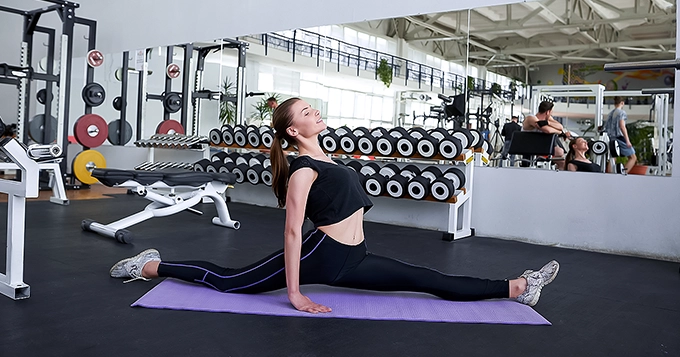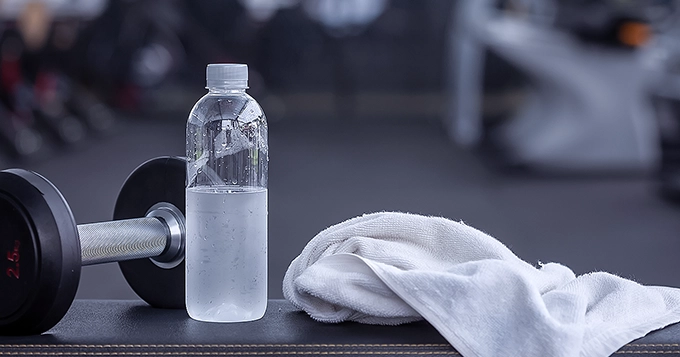
Key Takeaways
- Recovery relies on protein synthesis for muscle repair, which is essential for strength and endurance gains.
- Effective recovery needs proper nutrition to balance hormones and refill glycogen stores.
- Complete rehabilitation plans incorporate proper sleep patterns, a healthy diet, and equipment such as compression gear and cold therapy.
- Overtraining without proper rest can lead to fatigue and increase the risk of injuries.
- Effective recovery needs rest, proper nutrition, hydration, and mental relaxation.
Recovery is a key, though often underestimated, aspect of fitness. While challenging yourself during workouts is important, the recovery phase is essential for lasting success. Exercise leads to microtears and tension in your muscles, and recovery is how your body repairs and strengthens them, which helps in increasing muscle recovery and getting you ready to perform even better in your next workout.
Proper recovery isn’t just about resting. It’s about giving your body the right combination of sleep, nutrition, hydration, and active techniques to heal muscles faster and grow. You risk overtraining, injuries, and burnout without adequate recovery, derailing your progress. A well-designed recovery plan can boost your performance and endurance, helping you achieve your fitness goals.
This guide will cover the science behind recovery, its key elements, and practical strategies you can implement, including how to make muscles recover faster to make the most out of your workout routine. You can get greater outcomes and lower your chance of injury by learning how recovery functions and how to improve it. This will make sure that your fitness journey is both successful and long-lasting.
The Science Behind Recovery
To fully understand the importance of recovery, one must have a thorough understanding of the physiological processes that take place both during and after exercise. Any type of physical activity, whether endurance, cardio, or strength training, stresses and breaks down your muscles. This microtrauma to the muscle fibers is necessary for growth, but it also leads to soreness and fatigue. Recovery is the phase where your body works to repair this damage, rebuild muscles, and prepare for the next round of exercise.
A. Muscle Breakdown and Repair
During workouts, especially intense ones like weightlifting or high-intensity interval training (HIIT), your muscles are subjected to microscopic tears. These tears indicate your body adjusting to the strain of exercise and are natural. However, your muscles grow when you’re recovering. This is because the body repairs and replaces injured muscle fibers with new ones through a process known as muscle protein synthesis, which gradually increases strength and endurance.
B. Hormonal Response
The body’s hormone system is essential for recuperating from exercise. Important hormones that support muscle growth and repair after exercise include growth hormone and testosterone. Additionally, cortisol, a stress hormone released during exercise, must be managed during recovery, as prolonged high levels can hinder muscle repair and lead to overtraining.
C. Glycogen Replenishment
Your body uses its glycogen stores, which are the main energy source for muscles during physical activity while you exercise. Post-workout recovery includes replenishing these glycogen stores through proper nutrition, particularly carbohydrates. With adequate replenishment, you might feel energized during future workouts and see a dip in performance.
D. Role of Rest and Sleep
Even while muscles can heal themselves when at rest, sleep is the most important time for muscle healing. The body releases growth hormones and performs immune system enhancement, tissue repair, and metabolism regulation during deep sleep. Lack of sufficient sleep can dramatically reduce recovery time, increase the risk of injury, and impede progress toward fitness goals.
Overtraining syndrome can result from neglecting or undervaluing recovery, which can cause persistent fatigue, diminished performance, and even psychological burnout.
Key Elements of Effective Recovery

To optimize your fitness gains and reduce the risk of injury, it’s essential to incorporate multiple elements into your recovery routine. A well-rounded recovery process goes beyond just taking a day off from the gym—it involves addressing multiple aspects of physical and mental well-being to help heal muscles faster, recharge, and prepare for the next workout.
The following are the essential components of a successful recovery:
- Sleep: The Foundation of Recovery
Tips to Improve Sleep for Recovery:
- Create a consistent sleep schedule. Keeping a consistent wake-up and bedtime might help your body’s internal clock in harmony.
- Develop a pre-sleep routine. Your body can tell when to wind down by engaging in peaceful activities like reading or meditation.
- Make the most of your sleeping environment. Make sure your bedroom is calm, cold, and dark to encourage deeper sleep.
- Skip heavy meals and screen time before bed to prevent discomfort and facilitate sleep.
- Get nightly 7 to 9 hours of quality sleep to support muscle recovery and repair.
- Nutrition: Fueling the Recovery Process
Key Nutrients for Recovery:
- Protein: Consuming protein post-workout provides your body with the amino acids it needs for muscle protein synthesis. To help with recovery, aim to consume 20–30 grams of protein after working out.
- Carbohydrates: Carbs are essential for replenishing glycogen stores, especially after intense exercise. Combine protein with fast-digesting carbs (e.g., fruits, sweet potatoes) for a balanced post-workout meal.
- Hydration: All biological processes, including muscle repair, depend on water. Throughout the day, especially after exercise, consume lots of water. In more intense sessions, replenishing lost electrolytes (sodium, potassium, magnesium) can help maintain fluid balance and muscle function.
- Active Recovery: Low-Intensity Movement for Healing
Examples of Active Recovery:
- Walking or light cycling: These gentle exercises assist in maintaining bodily motion while sparing the muscles from undue stress.
- Swimming or water exercises: The buoyancy of water reduces the impact on joints and muscles, making it ideal for active recovery.
- Yoga or stretching: Gentle stretching helps increase flexibility, reduce muscle tension, and promote relaxation, all of which support recovery.
- Stretching & Foam Rolling: Easing Muscle Tension
Post-Workout Stretching
- Dynamic stretching before a workout enhances the range of motion and prepares the muscles for activity, while static stretching afterward helps lengthen muscles and relieve tension. After a workout, stretching helps lessen discomfort and gradually increase flexibility.
- Foam rolling (or self-myofascial release) targets muscle adhesions, also known as “knots,” that can form after intense exercise. Using a foam roller to roll out tense muscles promotes blood flow, breaks up scar tissue, and reduces muscle pain. Focus on major muscle groups worked during your training session (e.g., quads, hamstrings, back)
Recovery Tools and Techniques

- Cold Therapy (Ice Baths/Cold Showers)
Cold therapy is a popular technique among athletes for reducing muscle soreness and inflammation after intense workouts. The cold numbs the damaged area and constricts blood vessels, which helps to reduce swelling and pain perception.
How Cold Therapy Works:
When muscles are subjected to cold, blood flow is temporarily reduced, limiting inflammation. The removal of the cold promotes increased blood flow, which gives the muscles more oxygen and nutrients and hastens the healing process.
Benefits of Cold Therapy:
- Reduces post-exercise inflammation and swelling.
- Minimizes the discomfort caused by delayed onset muscular soreness or DOMS.
- Speeds up the process of muscle regeneration by getting rid of waste products from metabolism, such as lactic acid.
Common Methods:
- Ice bath: After engaging in high-intensity or endurance activities, submerging your body in cold water (between 50 and 59°F) for ten to fifteen minutes will assist in alleviating general muscular inflammation and stiffness.
- Cold showers: A more accessible option, cold showers can provide localized relief and improve blood circulation to the muscles.
Cold therapy has been shown to reduce inflammation and assist in increasing muscle recovery, especially after high-intensity workouts.
- Massage Therapy
Massage treatment is one of the most tried-and-true and effective recovery techniques. It’s well renowned for easing tense muscles, improving blood flow, and speeding healing.
Benefits of Massage Therapy:
- Aids in loosening tight muscles and alleviating soreness.
- Improves blood flow to the muscles, which enhances nutrient delivery and speeds up healing.
- Reduces muscle stiffness, preventing long-term injuries or mobility issues.
- Provides stress relief, promoting mental and emotional relaxation.
Types of Massage for Recovery:
- Sports massage: Focuses on deep tissue manipulation to alleviate muscle tightness and prevent injuries.
- Self-massage tools: Devices like massage guns or handheld rollers allow for convenient, at-home muscle relaxation by targeting specific sore or tight areas.
- Professional massage: Visiting a certified therapist can provide more comprehensive relief, especially if your muscles are experiencing significant tension after a workout cycle.
Massage therapy can be incorporated regularly (weekly or bi-weekly) or after particularly strenuous workouts to release muscle tension and aid recovery.
- Compression Gear
How Compression Gear Works:
- By preventing blood from accumulating in the muscles, compression helps lessen inflammation and edema.
- Faster recovery is made possible by improved circulation, which helps remove metabolic waste (like lactic acid) that builds up after exercise.
Benefits of Compression Gear:
- Lessens the sensation of weariness and soreness in the muscles, particularly after prolonged exercise like cycling or jogging.
- Helps prevent post-exercise swelling, especially in the lower legs and arms.
- Enhances recovery between training sessions by improving blood flow to fatigued muscles.
- Supplements for Recovery
Key Recovery Supplements:
Protein powder: One of the most popular and useful supplements that can quickly and effectively meet your post-workout protein requirements. It is quite beneficial for people who have trouble getting enough protein from whole foods.
Branched-Chain Amino Acids (BCAAs): Leucine, isoleucine, and valine are essential amino acids that boost muscle protein synthesis and minimize muscle breakdown, making them excellent for recovery, especially following resistance training.
Creatine: Well-known for its ability to improve strength and performance, creatine also enhances muscle recovery by increasing energy stores and reducing muscle damage.
Omega-3 Fatty Acids: Omega-3s present in fish oil have anti-inflammatory qualities that may help lessen muscle discomfort and hasten healing.
Common Mistakes That Hinder Recovery
Many people unknowingly sabotage their progress by making common mistakes in their recovery routine. These missteps can lead to prolonged soreness, fatigue, and even injury, hindering the body’s ability to heal muscles faster and grow stronger.
Are you optimizing your recovery? To get back on track with a well-planned exercise routine, check out our “Beginner Workout for Women” article. This plan is perfect for those looking to start strong and sidestep common recovery issues.
Understanding and avoiding these mistakes will help you maximize your workout recovery and continue making progress toward your fitness goals.
Here are some common factors that could hinder your recovery:
Overtraining is one of the most significant mistakes people make, often in the pursuit of quicker results. It happens when you push your body too hard, working out frequently without giving your muscles enough time to recover. This not only leads to overtraining syndrome, characterized by chronic fatigue, decreased performance, and irritability, but it also increases the risk of injury.
When you exercise, your muscles break down, and recovery is when they rebuild stronger. Without sufficient recovery time, your muscles remain in a constant state of breakdown, which can lead to stagnation or regression in your fitness progress.
Signs of Overtraining:
- Chronic muscular discomfort or joint pain.
- Inadequate sleep or trouble falling asleep.
- Decline in performance, even after consistent effort.
- Feeling tired, irritable, or unmotivated to work out.
How to Avoid Overtraining:
- Schedule regular rest days or lighter workout days (active recovery) to give your muscles a chance to heal.
- Monitor how your body feels and allow yourself to rest if you experience fatigue or soreness. Skipping one workout is better than risking long-term injury or burnout.
Exercise alone won’t get you the results you want—nutrition is a key component of the recovery process. Many people consume insufficient food or certain nutrients that aid in muscle growth and repair during exercise. You may experience fatigue and take longer to recover from your workout if you don’t get enough protein in your diet, skip post-workout meals, or don’t consume enough carbohydrates to replenish your glycogen stores.
Additionally, neglecting hydration is another common mistake. Maintaining adequate hydration is crucial for nourishing muscles and eliminating waste materials such as lactic acid. Dehydration may result in muscle cramps, hinder recovery speed, and impair muscle performance in future workouts.
How to Avoid These Mistakes:
- Eat a well-balanced post-workout meal that is low in protein to aid in muscle regeneration and rich in carbohydrates to replenish glycogen levels.
- Throughout the day, especially after working out, make sure you consume adequate water. Consider including electrolytes in your hydration regimen for longer or more strenuous sessions.
Many exercisers skip stretching, believing that it’s not essential for recovery. However, neglecting stretching can lead to muscle stiffness, reduced flexibility, and an increased risk of injury. Stretching helps elongate muscles, improve blood circulation, and alleviate post-workout tension.
Conversely, some people rely too heavily on passive recovery techniques like resting in bed all day, thinking it will speed up recovery. While rest is important, active recovery—light movement like walking or stretching—can be more effective in reducing soreness and promoting blood flow.
How to Avoid These Mistakes:
- To help with flexibility and muscular relaxation, incorporate static stretching after your workout and dynamic stretching before your next one.
- On recovery days, engage in gentle activities such as yoga, swimming, or walking to keep your muscles moving.
Pushing through pain and ignoring signs of overexertion is another mistake that can hinder recovery. Even though soreness is normal following a strenuous workout, discomfort that lasts longer or worsens could indicate an injury. Ignoring these warning signs could result in more significant problems that could take longer to heal, such as strained muscles, tendonitis, or stress fractures.
How to Avoid These Mistakes:
- Observe your body’s cues; if you experience pain, stop and give your muscles time to mend.
- Don’t feel guilty about taking rest days or adjusting your workout routine to prioritize recovery.
- Prioritize long-term development above quick gains, and keep in mind that maintaining fitness over time requires constant recovery.
Creating a Personalized Recovery Plan

Questions to Consider:
- How often do you work out?: The more frequent your sessions, the more recovery strategies you’ll need to avoid overtraining.
- What type of exercise are you doing? Strength training, HIIT, and running place more stress on the muscles, while low-impact activities like swimming or cycling may require less recovery time.
- What is your workout intensity?: Higher-intensity exercises (such as heavy lifting or sprinting) require longer recovery periods, whereas moderate-intensity workouts (like steady-state cardio) might allow for quicker recovery.
Muscle Building
Focus on sleep, nutrition, and protein intake to support muscle protein synthesis and repair. Ensure you’re getting enough calories and macronutrients to fuel growth and recovery. Incorporate foam rolling and active recovery to alleviate muscle soreness and maintain flexibility.
Fat Loss
Recovery is still essential for fat loss, as overtraining can lead to fatigue and a decrease in workout performance. The three things you should prioritize the most to keep your metabolism up without overstretching your muscles are sleep, water, and active recovery routines like yoga or walking.
Improving Endurance
For endurance athletes, such as runners or cyclists, recovery is about replenishing glycogen stores and maintaining joint health. Compression gear, cold therapy, and stretching can be helpful in reducing soreness and supporting faster recovery after long-duration workouts.
Enhancing Flexibility
For flexibility goals, stretching and foam rolling should be a regular part of your recovery routine. On days of active recovery, you might concentrate on yoga or mobility exercises to support your efforts at flexibility and stretching.
An effective recovery plan addresses multiple aspects of recovery, including physical, nutritional, and mental recovery. By balancing these elements, you’ll ensure that your body has everything it needs to repair and rejuvenate after exercise, which is key to how to make your body recover faster
Physical Recovery
Add rest days and active recovery to your weekly plan to prevent overtraining and reduce muscle fatigue. Rotate between more intense workout days and lighter recovery-focused activities, like stretching or walking.
Nutritional Recovery
Focus on post-workout nutrition by consuming a combination of protein and carbohydrates to help your muscles repair and restore energy. Supplements that reduce inflammation and encourage muscular growth, such as omega-3 fatty acids and BCAAs, can speed up recovery.
Mental Recovery
Healing on the physical and mental levels depends on learning to manage stress and finding time to unwind. Incorporate mindfulness practices, meditation, or even leisurely activities like reading or spending time outdoors to allow your mind to recharge. Remember that mental burnout can be just as detrimental to progress as physical fatigue.
How to Track Recovery:
- Keep a fitness journal: Keep track of your workouts, the amount of sleep you receive, how sore you feel the next day, and any other information that can affect your recuperation. In order to modify your plan this will assist you in recognizing patterns, such as times when you feel especially tired or sore.
- Use a fitness tracker: Heart rate variability, or HRV, is a metric that many fitness trackers measure, and it tells you how well your body is healing. A lower HRV signals that your body is stressed and may need more rest, whereas a higher HRV shows that your body is well-prepared for vigorous exercise.
- Monitor your performance: A decline in strength, endurance, or motivation during exercise may indicate inadequate recovery and suggest adjustments.




